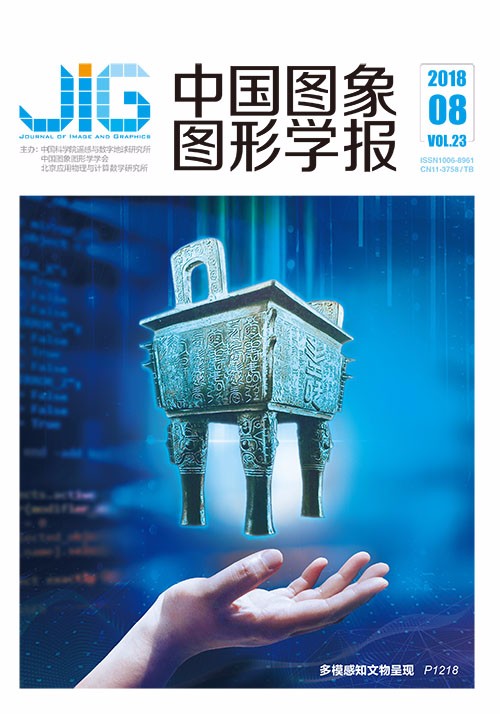
结构化低秩字典学习的人脸识别
摘 要
目的 现实中采集到的人脸图像通常受到光照、遮挡等环境因素的影响,使得同一类的人脸图像具有不同程度的差异性,不同类的人脸图像又具有不同程度的相似性,这极大地影响了人脸识别的准确性。为了解决上述问题对人脸识别造成的影响,在低秩矩阵恢复理论的基础上提出了具有识别力的结构化低秩字典学习的人脸识别算法。方法 该算法基于训练样本的标签信息将低秩正则化以及结构化稀疏同时引入到学习的具有识别力的字典上。在字典学习过程中,首先利用样本的重建误差约束样本与字典之间的关系;其次将Fisher准则应用到稀疏编码过程中,使其编码系数具有识别能力;由于训练样本中的噪声信息会影响字典的识别力,所以在低秩矩阵恢复理论的基础上将低秩正则化应用到字典学习过程中;接着,在字典学习过程中加入了结构化稀疏使其不丢失结构信息以保证对样本进行最优分类;最后再利用误差重构法对测试样本进行分类识别。结果 本文算法在AR以及ORL人脸数据库上分别进行了实验仿真。在AR人脸数据库中,为了分析样本不同维数对实验结果造成的影响,选取了第一时期拍摄的每人6幅图像,包括1幅围巾遮挡,2幅墨镜遮挡以及3幅脸部表情变化以及光照变化(未被遮挡)的图像作为训练样本,同时选取相同组合的样本图像作为测试样本,无论哪种方法,图像的维度越高识别率越高。对比SRC (sparse representation based on classification)算法与DKSVD (discriminative K-means singular value decomposition)算法的识别率可知,DKSVD算法通过字典学习减缓了训练样本中的不确定因素对识别结果的影响;对比DLRD_SR (discriminative low-rank dictionary learning for sparse representation)算法与FDDL (Fisher discriminative dictionary learning)算法的识别率可知,当图像有遮挡等噪声信息存在时,字典低秩化可以提高至少5.8%的识别率;对比本文算法与DLRD_SR算法可知,在字典学习的过程中加入Fisher准则后识别率显著提高,同时理想稀疏值能保证对样本进行最优的分类。当样本图像的维度达到500维时人脸图像在有围巾、墨镜遮挡的情况下识别率可达到85.2%;其中墨镜和围巾的遮挡程度分别可以看成是人脸图像的20%和40%,为了验证本文算法在不同脸部表情变化、光照改变以及遮挡情况下的有效性,根据训练样本的具体图像组合情况进行实验。无论哪种样本图像组合,本文算法在有遮挡存在的样本识别中具有显著优势。在训练样本只包含脸部表情变化、光照变化以及墨镜遮挡图像的情况下,本文算法的识别率高于其他算法至少2.7%,在训练样本只包含脸部表情变化、光照变化以及围巾遮挡图像的情况下,本文算法的识别率高于其他算法至少3.6%,在训练样本包含脸部表情变化、光照变化、围巾遮挡以及墨镜遮挡图像的情况下,其识别率高于其他算法至少1.9%。在ORL人脸数据库中,人脸图像在无遮挡的情况下识别率达到95.2%,稍低于FDDL算法的识别率;在随机块遮挡程度达到20%时,相比较于SRC算法、DKSVD算法、FDDL算法以及DLRD_SR算法,本文算法的识别率最高;当随机块遮挡程度达到50%时,以上算法的识别率均不高,但本文算法的其识别率仍然最高。结论 本文算法在人脸图像受到遮挡等因素的影响时具有一定的鲁棒性,实验结果表明该算法在人脸识别方面具有可行性。
关键词
Structured low-rank dictionary learning for face recognition
Li Kaiyu, Hu Yan, Cui Yifeng, Wang Ping, Xu Guili(Nanjing University of Aeronautics and Astronautics, Nanjing 211106, China) Abstract
Objective Face images collected from real people are usually influenced by environmental factors, such as illumination and occlusion. In this situation, face images from the same class have varying degrees of otherness, and face images from different classes have distinct degrees of similarity, which can greatly affect the accuracy of face recognition. To address these problems, a face recognition algorithm for discerning structured low-rank dictionary learning is put forward and it is based on the theory of low-rank matrix recovery. Method The proposed algorithm adds low-rank regularization and structured sparse to discern dictionary learning based on the label information of training samples. During dictionary learning, the proposed algorithm first adopts the reconstruction error of training samples to constrain the relationships between training samples and the dictionary. The algorithm then applies Fisher discrimination criterion to the coding coefficients of dictionary learning for the coding coefficients to maintain discrimination. The proposed algorithm also applies low-rank regularization to the dictionary on the basis of the theory of low-rank matrix recovery because the noise in the training samples can influence the discrimination of the dictionary. During dictionary learning, structured sparse is imposed to avoid losing structure information and guarantee optimal classification of samples. Finally, test samples can be classified on the basis of reconstruction error. Result Experiments regarding the proposed algorithm are performed on the AR and ORL face databases. In the AR face database, to analyze the effects of experimental results from the different dimensions of samples, training samples include six images in the first session, that is, one scarf occlusion image, two sunglasses occlusion images, and three facial expression change and illumination change images per person. Test samples are the same as training samples. Face recognition is higher as face image dimension is higher in any method. Comparing the face recognition rate of sparse representation based on classification (SRC) algorithm with that of discriminative KSVD (DKSVD) algorithm, DKSVD algorithm reduces the effects of recognition results from uncertain factors in training samples by dictionary learning. Comparing the face recognition rate of discriminative low-rank dictionary learning for sparse representation(DLRD_SR) algorithm with that of Fisher discriminative dictionary learning (FDDL) algorithm, the low-rank regularization of dictionary can improve the face recognition rate by at least 5.8% when images show noise information such as occlusion. Comparing the face recognition rate of the proposed algorithm with that of DLRD_SR algorithm, face recognition rate can be improved noticeably when Fisher discrimination criterion is imposed to dictionary learning, and the ideal sparse values guarantee the optimal classification of test samples. The face recognition rate of images of 500 dimensions, in which a part of images is occluded with scarf or sunglasses, is 85.2%. In the AR face database, the occlusion degrees using sunglasses and scarf can be regarded as 20% and 40% of the face image, respectively. To verify the validity of the proposed algorithm in different facial expression and illumination changes and with scarf and sunglasses occlusion, experiments are performed according to specific image combinations of training samples. In any image combination, the proposed algorithm exhibits prominent superiority in face recognition when the face images are occluded. In training samples of images containing only facial expression and illumination changes and sunglasses occlusion, the recognition rate of the proposed algorithm is higher than that of other algorithms by at least 2.7%. In training samples of images with only facial expression and illumination changes and scarf occlusion, the recognition rate of the proposed algorithm is higher than that of other algorithms by at least 3.6%. In training samples of images showing facial expression and illumination changes and sunglasses and scarf occlusions, the recognition rate of the proposed algorithm is higher than that of other algorithms by at least 1.9%.In the ORL face database, the face recognition rate of images without occlusion is 95.2%, which is slightly lower than the recognition rate of FDDL algorithm. When the degree of random block occlusion of face images increases up to 20%, the face recognition rate of the proposed algorithm is higher than SRC, DKSVD, FDDL, and DLRD_SR algorithms. When the degree of random block occlusion of face images increases up to 50%, the face recognition rates of the aforementioned algorithms are all low, whereas that of the proposed algorithm remains the highest. Conclusion The proposed algorithm features certain robustness when face images are influenced by different factors, such as occlusion. Results also show that the proposed algorithm possesses feasibility for face recognition.
Keywords
face recognition low-rank regularization label information structured sparse Fisher discrimination criterion dictionary learning
|



 中国图象图形学报 │ 京ICP备05080539号-4 │ 本系统由
中国图象图形学报 │ 京ICP备05080539号-4 │ 本系统由